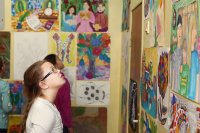Sharing Student Work Beyond the Classroom
The Share Your Learning campaign highlights the value of having students present their work to authentic audiences.
Your content has been saved!
Go to My Saved Content.Fifth graders from Sherman Elementary School in Tacoma, Washington, spent much of the 2017–18 school year investigating the health of the Salish Sea. As part of an interdisciplinary STEAM (science, technology, engineering, arts, and math) project, they conducted fieldwork and interviewed experts to learn about the coastal ecosystem that is literally in their backyard. To advocate for protections of this rich natural resource, they hosted an education night at a museum that sits on the waterfront.
“Sharing their projects with the wider community makes learning more real,” says teacher Julanne Boyd. Since Sherman Elementary adopted project-based learning as a key instructional strategy three years ago, students have gotten used to presenting to public audiences. And teachers have gotten bolder about taking student work outside the classroom. “At first, we were sharing just with our families. More and more, our students want to be out in the community,” says Boyd.
To bring similar benefits to many more schools, a national campaign called Share Your Learning aims to have 5 million students across the U.S. sharing their stories of learning by 2020. That will require the participation of 300,000 teachers.
“This could move the needle of what public education can look like,” says Mari Jones, co-director of the campaign. Share Your Learning is a project of the Deeper Learning Hub, funded by the Hewlett Foundation.
Presentations of learning “allow students to dig deeper into what education means,” says Jones. “It’s not just about doing some work, having the teacher see it, getting a grade, and moving on. If we want students to be ready for their future, they need opportunities for communication, collaboration, and all the things that presentations of learning allow students to do.”
Jones has seen those benefits firsthand. Before joining the campaign, she taught elementary school for several years in the High Tech High network in San Diego, where student exhibitions attract big audiences.
“Those connections with the community tell students, ‘Yes, your work matters. Yes, we see you,’” says Jones. Presentations are springboards for reflection, helping students develop an academic mindset. The experience also prompts teachers to reflect, Jones says. “As a teacher, you think about, what is the work students are sharing? Is it worth sharing? Does it demonstrate what I want to be teaching? If not, how can we make it better?”
Although project-based learning is one strategy that leads naturally to public presentations, it’s not the only instructional approach that sets the stage for student showcases. “You don’t have to use a particular instructional model,” Jones says, “if the outcome is that students are doing some sort of work that matters.”
In fact, the idea for the Share Your Learning campaign grew out of conversations among school leaders from the Deeper Learning Network, whose schools use a variety of models. “When they talked about what their schools have in common, these practices for sharing student learning were one of the key pieces,” Jones says.
How to Start
Getting started with student presentations doesn’t require overhauling how your school operates. Jones suggests “a few simple hacks” that can turn existing traditions into new opportunities to showcase student work and inspire deeper learning. Here are three ideas to help you get started.
From open house to exhibition of learning: If your school hosts an open house, you already have a structure in place for bringing parents into the building. “Often, student work is displayed for these events, but student reflection about the work may be missing,” Jones says. “What was the process that led to this product? What was the relevance to the learner?” Inviting students to talk with visitors about their successes and challenges can turn an open house into a meaningful exhibition of student learning.
From parent-teacher conference to student-led conference: Having students lead conversations about their learning changes the dynamic of parent conferences. “This is a relatively easy hack,” Jones says, and it gives students more of a voice in their learning. Student-led conferences can work across all grade levels.
From graduation requirements to presentations of learning: Instead of ticking off requirements for graduation, consider how learning would be amplified by having high school students defend their work before a panel of experts. “It’s not a far-fetched idea,” Jones says, especially as more schools move to performance-based graduation requirements.
“If teachers want to try one of the strategies,” adds Michelle Clark, co-director of Share Your Learning, “they will find clear steps.” That’s important, she adds, because 46 percent of teachers who have signed the campaign pledge so far “are doing these practices for the first time.”
By late spring 2018, teacher pledges to join the campaign translated to a reach of 1 million students. Participating teachers are asked to share their own stories and photos from their school events on Twitter using the hashtag #ShareYourLearning. That will help the campaign showcase examples from diverse contexts, inspiring even more schools to take part.
